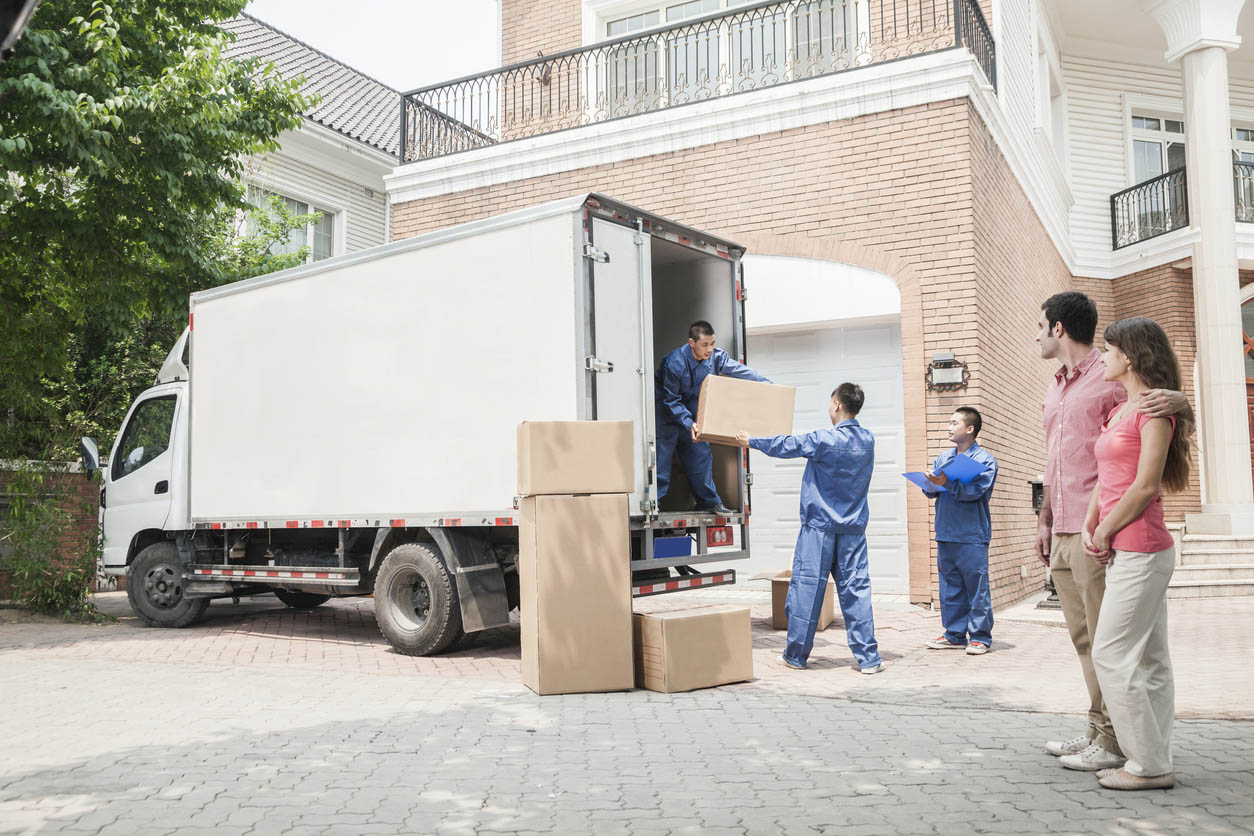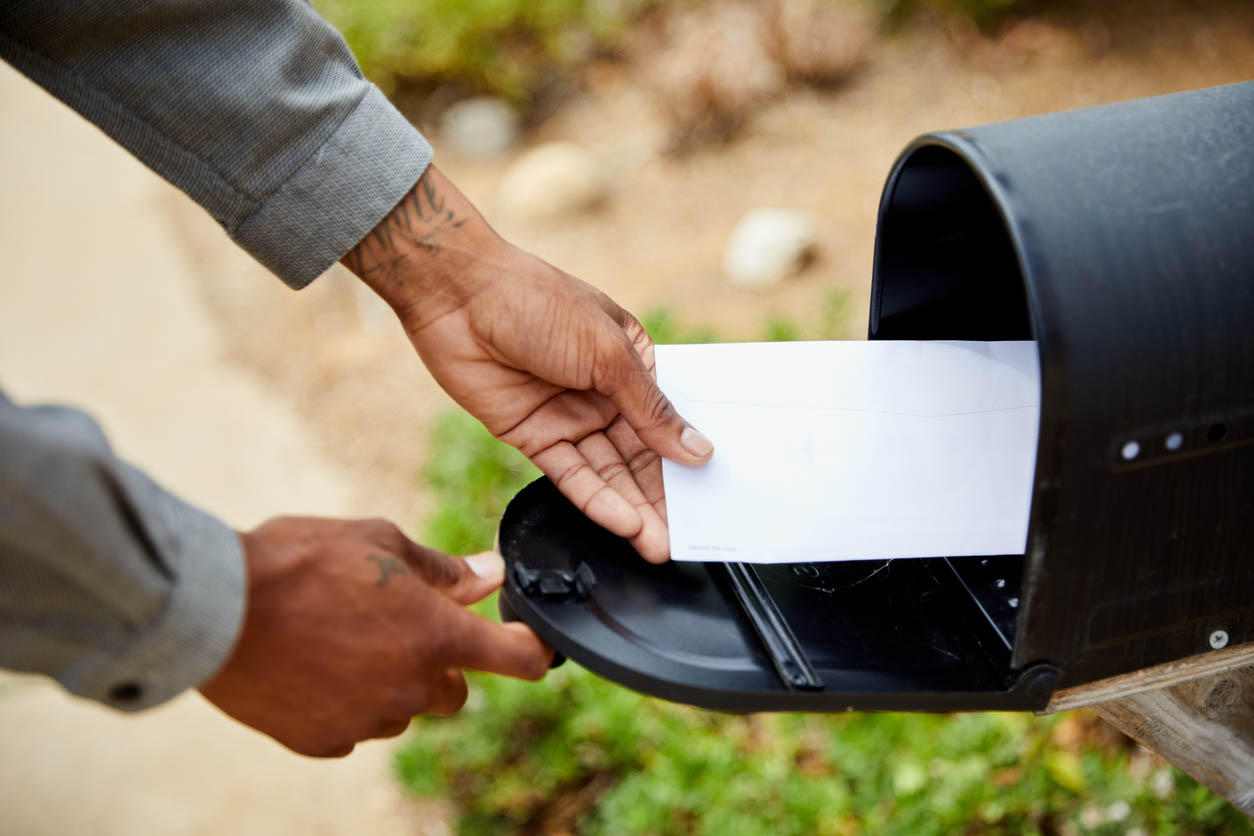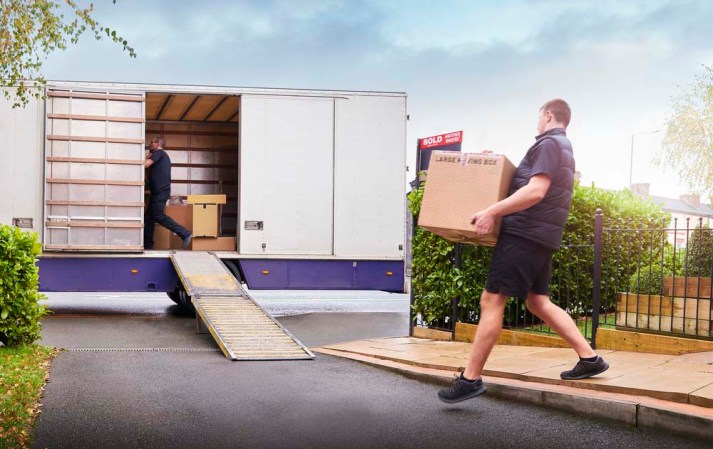We may earn revenue from the products available on this page and participate in affiliate programs. Learn More ›
With more and more workplaces deciding to save on overhead costs by shifting to remote work, the options of where you choose to live are wide open. If you’ve wondered how to move to another state, now might be the time. Maybe you’ve always dreamed of living near the mountains or the shore, and now that’s a possibility. Conversely, you might need to move to another state to keep a job or be near family.
Whether you’re moving for pleasure or out of necessity, moving is always a major stressor. Packing up all of your worldly goods, finding a new home, transferring records and services, and budgeting for your new life in a new place—all in what may be a limited time frame—can cause even the most meticulous planner to run for cover. Luckily, there are actionable steps and hirable services to help you figure out how to move to a different state.

Smart shipping. Easy tracking.
Bob Vila has partnered with uShip to help make shipping big stuff cheap and easy.
Get a Free Estimate
Time required: As long as you have before the move; preferably 3 to 6 months
Difficulty: Beginner
Estimated cost: Dependent on the distance and location of the move
Tools & Materials
Bobvila.com may earn a commission from purchases made through these links.
Before You Begin…

Ideally, you’ll have a solid 3 to 6 months between when you decide you’re moving to another state and when the move will occur. But life doesn’t always work out in an ideal way, so it may be that you’ll need to ramp up the speed of these steps for a much quicker move. In that case, consider renting a home or apartment in your new area in the short term, which will cut down considerably on the time you need to set up your new dwelling. Regardless of how much time you have, following the steps and staying organized will help you get it all done in time.
Tips for How to Move to Another State
- Begin planning early.
- Keep a moving-out-of-state checklist.
- Keep all of your materials in one place (a binder, folder, or all together in a computer folder) for easy reference.
- Ask for help from others—experts or friends and family—as often as you can.
- Accept that the process won’t be perfect and problems will occur. You’ll fix them.
Safety Considerations
- Many people will be asking for personal information during this process. Be cautious about how much information you choose to give out and to whom.
- Be discreet in your box labels: Try numbering them and keeping a log rather than advertising that a box is full of computer equipment, electronics, or jewelry.
STEP 1: Visit your prospective city and spend some time there.
You need to find a new place to live, but how can you do that until you feel the vibe of your new home city? You’ll want to visit, preferably including both weekdays and a weekend, to get the feel of the town, the neighborhoods, and the different housing options. Especially if you’re moving from a city to a small town or vice versa, it’s vital to understand the culture of the place you’re moving to before you choose a new house or apartment. Try out your commute routes (if you’ll be commuting); research school options for the kids; and check out the availability of parks, shops, restaurants, or recreation centers. This will help you select the town or part of town where you want to focus your home search and allow you to feel more confident that the change is a good one.

STEP 2: Make a budget for your move, including your new home, movers, and storage.
Moving is not inexpensive. If you’re moving for work, you may have a relocation budget to use. Otherwise, the expenses can mount: selling and buying a home (or putting down a security deposit before you have the current one back if you’re renting), paying movers, truck rentals, gas, temporary storage, pet boarding fees, plane tickets, and other unexpected expenses. Before you plan your move, look at your budget, consider any contribution from your employer, and determine how much you can afford to spend. Slice off a percentage to set aside for emergencies, and then begin to consider your options. Can you hire movers, or will you call on friends and family to help? (Bear in mind that you will need help unloading and unpacking at your new home as well.) It’s certainly easier to move when you’re paying someone else to do the heavy lifting, packing, and cleaning, but with some time, help, and preparation, you can do it for less. It also helps to have a folder or binder to keep all of your notes, paperwork, receipts, and more in one place.
STEP 3: Find a place to live, and choose a moving date.
Choosing a new home from afar is tricky. Renting for a short period might make sense while you learn the lay of the land in your new town, but making a home purchase might be preferable in some cases. A good real estate agent who is local to your new state makes a huge difference, whether you’re renting or buying: They can take you on virtual tours, help you define the neighborhoods that meet your criteria, and arrange local inspectors, as well as facilitate electronic document transfers and closings. Once you’ve secured a place to live, you’ll need to choose the date of your move. Consider the timing of your move to help preserve your budget. Midweek and mid-month moves are less expensive because the movers are less busy and more trucks are available for rent. You’ll also want to stay clear of holiday long weekends and college move-in and move-out weeks, as movers are in demand at those times and can charge higher rates.

STEP 4: Research moving companies and get quotes.
If you’re hiring movers, they will be transporting most of your possessions across state lines. If you’re making a cross-country move, this means the movers will have most of your possessions in their care for several days and nights. You need to choose carefully. Consult friends, neighbors, social media, movers’ guides, and the Better Business Bureau for recommendations about who to hire among the best moving companies (we recommend United Van Lines among others) and who to avoid. Talk to the movers’ representatives and invite them to your home to see what you’ll need moved for a more accurate quote, and get the quote in writing. As with any contractor, you’ll want to make sure the movers are insured, licensed to drive their trucks, and bonded, but you should also ask specifically about their policies on lost, stolen, or damaged goods. Remember that the most expensive is not necessarily the best.
Less-costly options include renting a moving truck to drive yourself or hiring a portable container, which can cost less and can bundle the cost of moving with the cost of storage if you’ll be living in temporary housing for a bit before you settle. However, it’s a good idea to ask for quotes for all of the options. You may think you’re saving by renting a truck or a container, but it may be close to the same cost for movers, depending on how much material you need to move.
Regardless of how you’re moving your household goods, you’ll need to consider how you’re transporting your cars. Especially in a cross-country move, driving more than one vehicle (or any vehicle) may not be practical. Some moving companies allow you to place the car in the moving truck with your belongings or hitch your car to the back of the truck. If you’re driving your own truck, you can rent the equipment to tow the car behind the truck, but be realistic about how you’ll feel about piloting a large truck in an unfamiliar area with a car suspended off the back. Otherwise, you can arrange to ship the car. Auto transport services can take as long as 2 weeks to ship across the country, so in addition to budgeting for the shipment itself, you’ll need to budget for a rental or borrow a friend’s car for those last weeks before you leave.
STEP 5: Make a packing plan, order moving supplies, and start packing.
Will you be packing your own possessions, or will movers do it as part of your contract? Either way, there are a few smart ideas you’ll want to use before the packing begins. Moving is a great time to sort through the items you own and decide what is worth packing, moving, and unpacking. Old clothes you haven’t worn, kitchen appliances you don’t use, items you put in the attic for reasons you don’t recall, or that one box in the basement that you haven’t opened since your last move—these are all candidates for donation, sale, or trash. When you’ve honed your possessions down to what you’re ready to move with, then it’s time to order moving boxes, tape, packing paper, and labels (order more tape than you think you’ll need). Check your local social media pages to see if you can score free boxes in good shape from new neighbors who have just moved, or check with the mailroom at your office or a local grocery store. Consider specialty packing boxes: If you have a lot of hanging clothes, wardrobe boxes might be a reasonable investment and a huge time-saver, and you can often resell them after you’ve moved. Lots of dishes, wine glasses, or high-quality artwork? Think about specially designed packs of moving materials with dividers and dedicated padding.
Start packing the items you won’t need first. Off-season clothes, photos, books, infrequently used dishes—pack those first, and work toward the things you regularly use. Consider keeping a running log of what you pack in which boxes, numbering the boxes, and labeling them only with the room they’ll be going to and the number. This will help keep nosy passersby from trying to swipe an attractively labeled box of electronics during the busy move-in and move-out days.
Finally, even if movers are packing your boxes, consider packing boxes of precious or irreplaceable photos and heirlooms yourself and moving them with you. Things get lost or damaged even in the most careful, professional moves, and anything that can’t be replaced or would cause heartbreak if lost is better off with you.
STEP 6: Consider any additional travel arrangements or accommodations.
Will you be moving on the day that your furniture and possessions are placed on the truck? Or will you need a hotel room for a few days before you travel? How are you getting to your new home state? These are plans you’ll want to have in place well ahead of time so you’re not scrambling at the last moment. Some movers suggest making a hotel reservation for the night of your planned move just in case something goes wrong with your closing or the movers have a problem with the truck; if this offers you extra peace of mind, add it to your list.
Pets can be an additional challenge, depending on where you’re moving. If you’re flying to your new home, you’ll need to make arrangements for your pet’s travel. Some cities have restrictions on the number or type of pets you can have or require quarantines before bringing the pet into the state. Check with your new state to make sure you know how to relocate your pet with your family.

STEP 7: Forward your mail and obtain or transfer any important records.
Once you’ve figured out how to move out of state, you’ll need to make sure your mail and accounts move with you. First, you’ll want to go to the United States Postal Service’s Address Change page. There you can change your address formally with the USPS and set the terms and length of time you’d like your mail forwarded. While the USPS is pretty good about forwarding mail, this should be the backup plan: What you really need to do is change the address with everyone who sends you mail or with whom you have an account.
You should begin making the list of places from which you receive physical mail as soon as you decide to move. In addition, start making a list of bills you pay online or automatically (your credit card and bank statements, along with PayPal or other payment methods, will help you check these). You’ll need to change the address manually for these services, especially those that don’t use the postal service. This can be a tedious process that takes a while because you’ll need to log in to each account and change the address. Think outside the box to make sure you include services and institutions that don’t send mail every month, such as your current employer, your new employer (if different), and the IRS. Most correspondence from the Department of Revenue can’t be forwarded, so you could miss important notifications if you don’t change the address.
You’ll also need to move your identity. Your driver’s license, car registration, and car insurance must all reflect your new residence. While you can’t make some of those changes until you get to your new home, it’s a good idea to find out ahead of time what kind of grace period your new state allows to avoid accidentally waiting too long. If you use a local bank, you’ll also need to find a new one in your area (or a new branch of your national bank). Collect significant medical records for yourself, your family, and any pets, and keep these documents safe. If you have children, you’ll need to arrange to have their school records transferred to their new schools so your kids can be placed in appropriate classes before they arrive. Finally, you’ll want to transfer your voter registration—in some states, this can be done when you get your new driver’s license or at the post office when you change your address, but not in others.
STEP 8: Cancel your utilities and any local subscriptions.
There are several steps you need to take to transfer your residence. You’ll need to schedule the closure of utility accounts at your old residence and set them up at the new one. Water, electricity, power, and gas or oil, telephone, internet, and potentially cell phone service all need to be switched. If you have a home security system through a national company, you may need to arrange to have your equipment removed and reinstalled and your service transferred to the new address. Depending on how far you’re moving and which companies service those areas, you may be able to transfer service instead of canceling and restarting. Remember to cancel local services like gym memberships, especially if the services require you to cancel in person instead of over the phone or online.
STEP 9: Pack your personal essentials.
A longer-haul move means you’ll likely arrive in your new state before your moving truck, so you’ll need to be prepared to be without your belongings for a while. Clothes for everyone in your family, medications, personal care supplies, and snacks should be packed in a bag you can carry with you. In addition, critical personal papers should be with you, not in the moving truck, including passports, birth certificates, social security cards, and insurance cards. You’ll also want to have with you contact information for your movers, insurance companies, and anyone in your new home that you might need to reach. Electronics, especially any with sensitive information on them, should also be with you, as should chargers for portable devices. If you’re traveling with children, comfort items to make this exciting but potentially scary journey a little easier go a long way toward keeping everyone happy. And throw a roll of toilet paper in the bag—there’s no telling if the previous residents of your new home will have left one in place!
STEP 10: Hire and schedule a move-out cleaner.
Even if you’ve kept a spotless home, the shuffling in and out of moving can leave a mess behind. Save your energy and do the new residents a true kindness by hiring professionals to give your old home a thorough scrub. If you were renting your old home, cleaning is essential—most leases stipulate leaving the house in good condition or risk losing your security deposit.

STEP 11: Hand your keys over to the new owners or landlord.
The last stop before you leave: officially transferring the ownership of your home to its new residents or back to your landlord. This may occur at the closing of the sale or across a desk in an office, but it’s the last step in leaving your old home. Be prepared to feel a little emotional about this moment, even if that emotion is relief that you completed your move-out in time! Remember, you’re making a significant change, and this moment is like casting the dock ropes off the side of your boat.
STEP 12: Communicate with your movers to ensure a seamless move.
It’s essential to stay in touch with your movers throughout the moving process; this is not a situation where you can assume that no news is good news. Confirm the date and time of the move a few days beforehand. Once the trucks are on the road, you’ll want to check that everything is on schedule and moving along as planned and be aware of any hiccups that might occur along the way to help establish contingency plans that you’re comfortable with. While you’ve selected a mover that is insured and bonded and has a solid reputation, they’re still carrying most of your possessions, so it’s absolutely within your rights to ask for status checks and updates to make sure everything runs smoothly.
STEP 13: Establish your new home.
Some states require that you formally establish a domicile in your new home for tax purposes. You can check the state government website for specifics. In some cases, establishing domicile is as simple as having bills sent to the new address and acquiring a driver’s license or identification card within a certain period. At the same time, in other states, you’ll need to file a state tax document announcing the date of your arrival. You’ll likely have to file taxes in both states for the first year of residence (and potentially the second, depending on when you move), so you’ll want the date you changed residence to be formally recorded.
Moving to a new state isn’t an easy job, but if you’re patient, cross off one item at a time on your moving-to-another-state checklist, and keep everything in one place, you’ll be able to settle into your new home with the satisfaction of knowing you’re getting a fresh start. Then you’ll have another to-do list: meeting your neighbors, making connections in your new community, and finding a favorite ice cream spot!

















